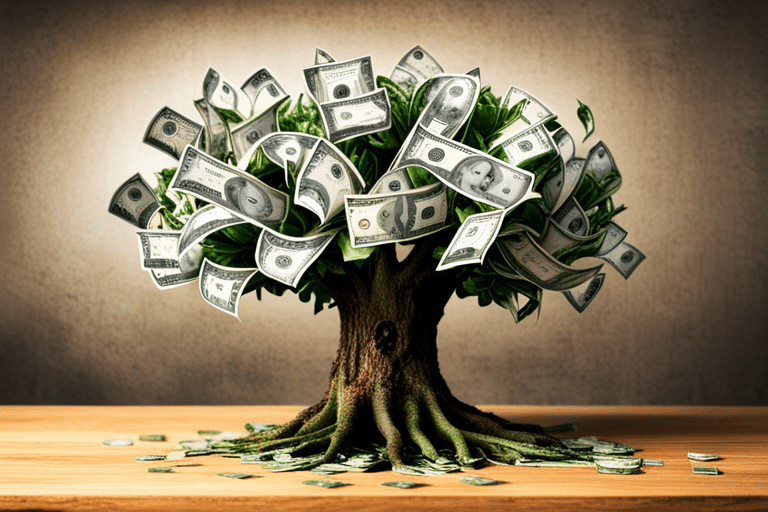Are you ready to embark on a profitable journey through the world of dividend stocks?
Discover the secrets to generating passive income through savvy investing.
This article will guide you through the basics, help you identify high-yield stocks, and provide strategies for building a diversified portfolio.
Learn how reinvesting dividends can lead to compounding growth and understand the implications of dividend taxation.
Delve into the risks and rewards of this lucrative investment option.
Get ready to master the art of dividend stocks!
Key Takeaways
- Dividend growth is important when choosing stocks
- Regular dividend payouts indicate a reliable source of passive income
- Diversifying by investing in companies from various sectors and industries helps reduce risk
- Reinvesting dividends accelerates growth and increases future dividend payments
The Basics of Dividend Investing

To start investing in dividend stocks, you’ll need to understand the basics of how dividends work and how they can generate passive income for you. It’s like having a money tree that keeps on giving without any effort on your part. So, let’s dive into the wonderful world of dividend investing!
Dividend growth is one of the key factors to consider when choosing dividend stocks. You want a company that has a track record of increasing its dividends over time. Think of it as getting a raise every year without having to ask your boss for one! Companies that consistently grow their dividends are often well-managed and financially stable, which bodes well for your investment.
Another important concept is the dividend payout ratio. This ratio tells you how much of a company’s earnings are being paid out as dividends. A lower ratio indicates that the company is retaining more earnings to reinvest back into the business, while a higher ratio means more cash is being distributed to shareholders. It’s like sharing a big slice of pie versus just crumbs!
Understanding these basics will help you make informed decisions when picking dividend stocks. You want companies with strong dividend growth and reasonable payout ratios. But don’t worry if all this seems overwhelming at first – mastery takes time! Start small, do your research, and gradually build up your portfolio.
Identifying High-Yield Dividend Stocks

So, you wanna know how to identify those high-yield dividend stocks, huh? Well, first things first – you need to understand the criteria for selection.
It’s all about finding companies with a track record of consistent dividends, solid financials, and sustainable business models.
But hey, don’t forget about risk and returns! You’ll wanna strike that perfect balance between a juicy yield and a reasonable level of risk because let’s face it – nobody wants their investments going down the drain.
Stay tuned as we delve into this exciting world of high-yield dividend stocks!
Criteria for Selection
When selecting dividend stocks, you should consider the company’s financial stability and track record of consistent payouts. It’s important to choose companies that are financially healthy and have a history of regularly paying dividends to their shareholders. This ensures that you can rely on a steady stream of passive income from your investments.
To help you in your selection process, here is a handy table that outlines the criteria for evaluating dividend stocks:
| Criteria | Explanation | Importance |
|---|---|---|
| Financial Stability | Look for companies with strong balance sheets | High |
| Consistent Payouts | Check if the company has a history of regular dividends | High |
| Dividend Yield | Evaluate the ratio between dividend amount and stock price | Medium |
Risk and Returns
By carefully analyzing the risks and potential returns, you can make informed decisions about which investments offer the best opportunities for growth. Investing is like a thrilling roller coaster ride, with ups and downs that can leave your heart pounding.
Here are three emotions you may experience when it comes to risk management and investment performance:
-
Excitement: The anticipation of high returns can be exhilarating, making you feel like you’re on top of the world.
-
Fear: The fear of losing money can send shivers down your spine, causing doubt and hesitation.
-
Confidence: When your investments perform well, it boosts your confidence and gives you a sense of accomplishment.
Strategies for Building a Diversified Dividend Portfolio

To build a diversified dividend portfolio, you should consider investing in companies from various sectors and industries. Why limit yourself to just one type of company when there are so many options out there? By spreading your investments across different sectors, you can reduce the risk of putting all your eggs in one basket. Plus, it adds a little excitement to your portfolio – like going on a culinary adventure and trying dishes from different countries.
Think of it this way: if you only invested in technology companies and the tech market took a hit, your entire portfolio would suffer. But if you had some healthcare stocks or consumer goods stocks as well, those sectors might be able to help offset any losses. It’s like having backup dancers on stage with you – they can pick up the slack if you stumble.
When building your diversified dividend portfolio, don’t forget about dividend investing strategies. Dividends are like little bonus checks that companies give their shareholders as a thank-you for investing in them. So why not make sure you get the most bang for your buck? Look for companies that have a history of increasing their dividends over time. These are often called ‘dividend aristocrats’ because they have proven themselves to be reliable income generators.
Reinvesting Dividends for Compounding Growth

Don’t underestimate the power of reinvesting your dividends. It’s like planting seeds that will grow into a flourishing garden of wealth over time.
By reinvesting your dividends, you can take advantage of the compounding benefits and turbocharge your investment returns.
Here are three reasons why reinvesting dividends is a smart move:
-
Accelerated growth: When you reinvest your dividends, you’re essentially putting those earnings back to work for you. This means that over time, your initial investment will grow faster than if you just pocketed the dividend cash. It’s like having an extra sprinkling of magic on top of your investment cake!
-
Diversified income streams: Reinvesting dividends allows you to diversify and increase the number of shares in your portfolio. With more shares, not only will you receive larger dividend payments in the future, but you’ll also have a broader range of investments working for you. It’s like having multiple fruit trees in your garden, each bearing its own delicious harvest.
-
Momentum-building effect: As you consistently reinvest your dividends, the compounding effect kicks in and starts to build momentum. Each reinvestment adds another layer to the snowball rolling down the hill, making it bigger and more powerful with every passing year. Before long, that snowball could become an avalanche of wealth!
So don’t let those dividend payments slip through your fingers! Reinvest them and watch as they multiply and grow into something truly remarkable.
Understanding Dividend Taxation and Its Implications

So you’ve been diligently reinvesting your dividend income, growing your portfolio and enjoying the benefits of compounding growth. Well done, my friend! But now it’s time to talk about another important aspect of dividend investing – understanding dividend taxation and its implications.
When it comes to dividends, taxes can play a significant role in how much money ends up in your pocket. The tax treatment of dividends can vary depending on your country of residence and the tax laws in place. In some cases, dividends may be subject to additional taxes or have different rates compared to other forms of income.
One key consideration is the dividend tax rate. This is the percentage of your dividend income that you’ll owe in taxes. It’s essential to know this rate so that you can accurately calculate your potential tax liability. Different countries have different rates, so make sure you’re aware of what applies to you.
Another crucial concept is tax-efficient dividend investing. This approach focuses on maximizing after-tax returns by strategically selecting investments with favorable tax treatment. For example, certain types of dividends may be taxed at a lower rate than others or even receive special exemptions.
To navigate these complexities effectively, it’s wise to consult with a qualified tax advisor who can help optimize your investment strategy while minimizing any unnecessary tax burdens.
Evaluating the Risks and Rewards of Dividend Stocks

So, you’re thinking about diving into the world of dividend stocks? Well, buckle up and get ready for a wild ride!
In this discussion, we’ll be exploring the exciting realm of risk versus reward analysis when it comes to investing in dividend stocks.
We’ll also take a closer look at their long-term investment potential and why they might just become your new favorite money-making machine.
Risk Vs. Reward Analysis
Investors should carefully assess the risk-reward ratio when evaluating dividend stocks. It’s like trying to find the perfect balance between eating a slice of cake and going to the gym later. You want to enjoy the sweetness of passive income without compromising your financial well-being.
So, here are three things that will make you feel as confident as a tightrope walker with a safety net:
-
Risk Mitigation: Think of it as wearing sunscreen on a sunny day. Diversify your portfolio, analyze company fundamentals, and keep an eye on market trends.
-
Investment Analysis: Just like solving a puzzle, analyze historical performance, dividend growth rate, and payout ratio to understand if the stock is worth your investment.
Long-Term Investment Potential
So, you’ve weighed the risks and rewards of investing in dividend stocks. Now it’s time to delve into the long-term investment potential and income generation strategies that come with it.
When it comes to long-term investments, dividend stocks are like the tortoise in the race against the hare. They may not provide immediate gratification like those quick-buck schemes, but they offer steady growth and a reliable source of passive income.
One key strategy for maximizing your income generation potential is reinvesting your dividends. Instead of cashing out those sweet payouts, consider plowing them back into more shares of the same stock or diversifying your portfolio.
Another approach is to focus on companies with a history of consistently increasing their dividends over time. These ‘dividend aristocrats’ have proven their ability to weather economic storms and reward their shareholders through thick and thin.
By adopting these long-term investment strategies and capitalizing on the income generation potential of dividend stocks, you’ll be well on your way to building a solid financial future.
Frequently Asked Questions
How Do I Determine if a Company Is Likely to Continue Paying Dividends in the Future?
To determine if a company will keep paying dividends, do some company analysis. Look at their financial health, cash flow, and dividend history. This can give you an idea of the dividend sustainability.
Can You Recommend Any Specific High-Yield Dividend Stocks to Invest In?
Looking for high-yield dividend stocks? Well, my friend, I’ve got just the answer for you. When it comes to investing in these gems, make sure to analyze dividend stock factors and consider what affects their payments. Happy investing!
What Are Some Common Strategies for Timing Dividend Stock Purchases?
Timing strategies for dividend stock purchases involve monitoring market trends, analyzing company performance, and considering dividend reinvestment plans. These can help maximize your passive income potential and make investing a strategic and rewarding experience.
Are There Any Tax Advantages to Investing in Dividend Stocks?
Investing in dividend stocks can offer tax advantages. You’ll be pleased to know that these stocks are often taxed at lower rates than regular income. So, get ready to boost your passive income!
What Are the Potential Downsides or Risks of Investing in Dividend Stocks?
Investing in dividend stocks has potential drawbacks and risks, but don’t fret! You can mitigate them by diversifying your portfolio, researching companies thoroughly, and staying updated on market trends. Happy investing!
Conclusion
So there you have it, my friend! Dividend stocks are a fantastic way to generate passive income and watch your money grow. By investing in high-yield dividend stocks and building a diversified portfolio, you can set yourself up for financial success.
And don’t forget about the power of reinvesting those dividends to compound your growth even further! But hey, before you dive in headfirst, make sure to understand the tax implications and evaluate the risks.
After all, with great rewards come great responsibilities, right? Happy investing! Can you hear the sound of your money multiplying?

